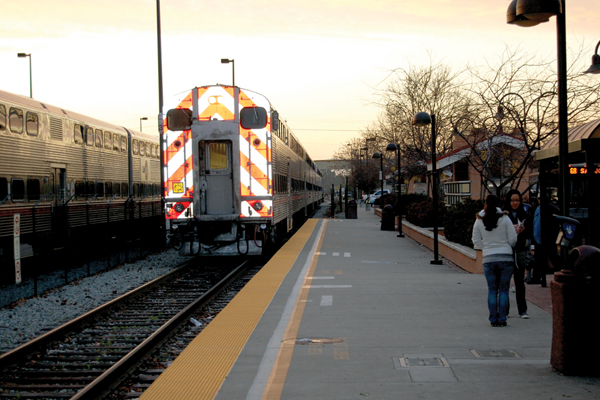To end a political standoff and keep Caltrain service going all
the way to Gilroy for at least another year, local transportation
officials might be forced to spot a long-time contributor whose
inability to pay its full share of funds equates to the bulk of a
$30 million revenue shortfall for next year.
To end a political standoff and keep Caltrain service going all the way to Gilroy for at least another year, local transportation officials might be forced to spot a long-time contributor whose inability to pay its full share of funds equates to the bulk of a $30 million revenue shortfall for next year.
If the Santa Clara Valley Transportation Authority ends up agreeing to cover the costs of the San Mateo Transit District for Caltrain this year, it will only be temporary. Officials note the situation stresses the importance of finding a more stable, permanent source of new revenue to keep the commuter train running to South County.
“I expect that at the end of the day, we will do what we have to do, and we will find a mechanism at the VTA board level to maintain Caltrain because it is such a vital service,” said Perry Woodward, VTA board member and Gilroy councilman.
That could be in the form of a loan, though Woodward and other local officials clearly stated they do not want to “subsidize” Sam Trans.
Caltrain is operating with a $102-million budget for the fiscal year that ends June 30. This year, about 47 percent of that revenue has been provided through passenger fares.
The rest of the funding mostly comes from the three transit agencies through the territory that Caltrain operates in – VTA, Sam Trans and the San Francisco Municipal Transportation Agency. Each agency’s share of funding is based on a formula adopted by the Caltrain joint powers authority, with Sam Trans contributing the most and San Francisco the least.
For fiscal year 2010-2011, Sam Trans provided about $14.7 million in Caltrain funding, VTA about $14.1 million, and SFMTA about $6.2 million.
But for this year, Sam Trans has proposed dropping its share significantly, to about $4.7 million. If that happens, based on the joint-powers formula the other two agencies would have to drop their portion of Caltrain proportionately, and the trio of transit agencies would collectively remit $24 million less to the Caltrain budget than last year.
Sam Trans is simply unable to continue funding its core services plus Caltrain in light of declining revenues in recent years, according to Christine Dunn, Caltrain and Sam Trans spokeswoman.
“Sam Trans’s primary function is to provide bus service,” Dunn said. “If (Sam Trans) takes away funds from its operating budget to support Caltrain, it will not be able to perform its core function.”
This creates what Woodward called “a difficult political problem.”
Caltrain is now on the verge of declaring a fiscal emergency, and VTA might have to subvert the traditional funding formula and perhaps loan Sam Trans the cash to cover its share of funding until a more long-term solution can be found, according to VTA representatives who do not think VTA should be “subsidizing” Sam Trans services.
“It can’t be a permanent solution,” Woodward said. “If we can talk to Sam Trans, maybe we can loan them the money for a year or two years, so we don’t step into the role of bankrolling (their) commitment.”
Such an action has not yet been officially proposed or voted on.
VTA has enough cash to fully fund its usual share of the Caltrain budget, Woodward said.
The most dramatic service cut to Caltrain proposed as a way to close the funding deficit is to eliminate all service south of Diridon station in San Jose – meaning all service to Morgan Hill, San Martin and Gilroy would be cut. That would reduce the number of daily trains from 86 to 48. Even if that proposal is enacted, and all three agencies reduce their funding, the commuter train would still run a $4.7 million deficit, according to Caltrain staff.
It costs Caltrain $700,000 annually to keep service going south of Diridon station in downtown San Jose, Woodward said.
Even if VTA finds a way to cover Sam Trans’ share of the Caltrain budget, Larry Carr – Morgan Hill councilman and VTA policy group member – agrees Santa Clara County tax dollars should not be used to subsidize San Mateo County’s bus services.
Cat Tucker, Gilroy councilwoman and VTA policy advisory committee member, said she didn’t think the VTA should have to offer more funds if Sam Trans couldn’t hold up its end. She said all three funding sources should pay the same amount.
“We shouldn’t subsidize San Mateo County,” she said.
The funding imbalance is one sign of the need for a more permanent long-term funding source for Caltrain. Last week, the Morgan Hill City Council agreed to contribute $3,000 to a public outreach effort by the Silicon Valley Leadership Group to raise awareness of this need and to seek the best possible funding source, which could come in the form of a voter-approved special tax or private investment. Woodward said he will ask the Gilroy Council to consider contributing a similar amount of local funding to the same effort.
Ridership on Caltrain has been in decline in recent years, and about 39,000 people board the train daily, from Gilroy to San Francisco. In February 2010, stations in Gilroy and Morgan Hill ranked 24th and 25th respectively out of 29 locations in average daily passengers, according to the ridership numbers released by Caltrain in May 2010. San Martin’s station was 28th with 45 average daily riders.
According to Caltrain, 119 people boarded the train in Gilroy on average, while 105 boarded in Morgan Hill. Those numbers accounted for a little more than one-half of 1 percent of Caltrain’s passengers for the month.
At a public meeting on the Caltrain budget situation last week in Gilroy, Michelle Bouchard, Caltrain’s deputy director of rail operations, outlined proposed fare increases in 25-cent increments. A one way ticket from Gilroy, Morgan Hill or San Martin to San Jose would rise from $6.50 to $6.75 one way and jump from $13.00 to $13.50 for a day pass.
Reporter Mark Powell contributed to this story.
***
What local authorities could do
– The VTA, a partner in Caltrain’s joint powers board, could loan Sam Trans – another partner who is short on cash – its usual share of funding but avoid “subsidizing” the San Mateo County agency.
– VTA and Sam Trans could renegotiate a Caltrain right-of-way purchase agreement, putting an extra $7 million into Sam Trans’ hands only if they agree to use the funds strictly for Caltrain operations.
– Caltrain could divert funds from Regional Measure 2 operating funds dedicated to the Dumbarton Rail project, which is too costly to pursue this year. Such a proposal could “provide immediate financial relief for Caltrain, if allowable by current law,” according to a Caltrain staff memo.
– Caltrain could divert up to $191 million in available funding for electrification of Caltrain tracks – a long-stalled project that doesn’t appear to be going anywhere soon, largely due to uncertainty over the state’s High-Speed Rail route.
– Caltrain could consider selling some of its property, such as Diridon station and parking lots it owns, to raise revenue for operations.










